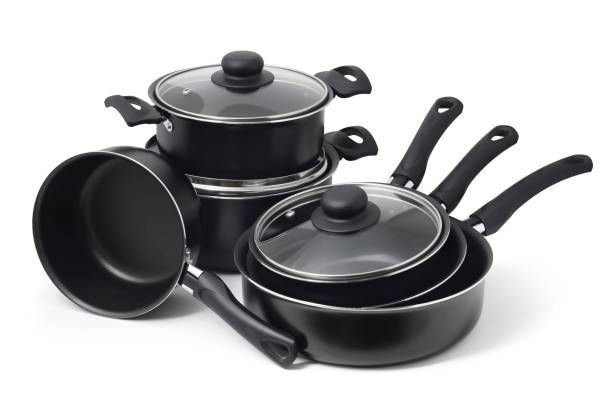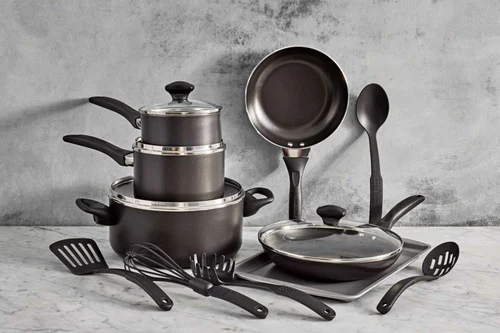Nonstick cookware has revolutionized the way we prepare meals, making cooking and cleanup easier than ever. With its ability to prevent food from sticking, it has become a kitchen staple in homes around the world. In this comprehensive guide, we will explore the benefits of nonstick cookware, the different types available, and essential care tips to ensure your cookware lasts for years to come.
What is Nonstick Cookware?
Nonstick cookware refers to pots, pans, and bakeware that have a coating designed to reduce friction and prevent food from adhering to the surface. This innovative technology not only makes cooking more enjoyable but also promotes healthier eating by allowing you to use less oil or fat when preparing meals.
Benefits of Nonstick Cookware

- Easy Cooking and Cleanup
One of the most significant advantages of this cookware is its ease of use. Foods slide off easily, minimizing the need for excessive oils and fats. This feature also means that cleanup is a breeze—most nonstick surfaces can be wiped clean with a soft sponge and warm, soapy water. - Healthier Cooking
With this cookware, you can significantly reduce the amount of cooking oil or butter needed in your dishes. This reduction can lead to lower calorie meals, making it a popular choice for health-conscious cooks. - Even Heat Distribution
Nonstick cookware often offers excellent heat distribution, allowing for more uniform cooking. This means your pancakes will cook evenly, your steaks will sear perfectly, and your sauces won’t scorch. - Lightweight and Durable
Many nonstick pans are made from lightweight materials, making them easy to handle and maneuver in the kitchen. Moreover, high-quality nonstick cookware is designed to be durable and resistant to scratches and chipping, ensuring that it lasts for years with proper care. - Versatility
Nonstick pans is incredibly versatile. It can be used for a variety of cooking methods, including frying, sautéing, baking, and even roasting. Whether you’re whipping up a quick breakfast or preparing a gourmet dinner, nonstick cookware has you covered.
Types of Nonstick Cookware
When it comes to nonstick cookware, there are several types to choose from. Each type has its unique properties and benefits, catering to different cooking needs and preferences.
- Teflon Cookware
Teflon is perhaps the most well-known nonstick coating. It offers excellent nonstick properties and is available in a variety of cookware styles. However, it’s essential to use Teflon at low to medium heat to prevent damage to the coating. - Ceramic Cookware
Ceramic nonstick cookware is made from natural materials and coated with a ceramic finish. This type is a great option for those looking for a chemical-free alternative. Ceramic cookware can withstand higher temperatures than Teflon but may not be as durable over time. - Anodized Aluminum Cookware
Anodized aluminum cookware is both lightweight and sturdy. The anodization process enhances its durability and makes it more resistant to scratches. This cookware often has a nonstick coating that offers excellent food release properties. - Cast Iron Cookware with Nonstick Coating
While traditional cast iron cookware requires seasoning to maintain its nonstick properties, some brands offer cast iron with a nonstick coating. This type combines the benefits of cast iron’s heat retention with the ease of nonstick cooking. - Stainless Steel with Nonstick Coating
Some stainless steel cookware comes with a nonstick coating, providing the best of both worlds. It offers the durability and longevity of stainless steel with the ease of nonstick cooking.
Choosing the Right Nonstick Cookware
When selecting this cookware, consider the following factors:
- Material: Decide which material best suits your cooking style and preferences.
- Durability: Look for cookware with a reputation for durability and scratch resistance.
- Heat Resistance: Ensure that the cookware can withstand the cooking temperatures you typically use.
- Size and Shape: Choose sizes and shapes that fit your cooking needs, from frying pans to saucepans and beyond.

Care Tips for Nonstick Cookware
To ensure your nonstick cookware remains in excellent condition, follow these care tips:
- Use the Right Utensils
Avoid using metal utensils that can scratch the nonstick surface. Instead, opt for silicone, wooden, or plastic utensils to preserve the coating. - Cook on Low to Medium Heat
High heat can damage nonstick coatings. Stick to low to medium heat for the best cooking results and to prolong the life of your cookware. - Avoid Abrasive Cleaners
When cleaning nonstick cookware, use gentle sponges or cloths and avoid abrasive cleaners that can scratch the surface. A simple mixture of warm water and mild dish soap is usually sufficient. - Store Carefully
To prevent scratching, stack nonstick pans with a layer of paper towels or cloth in between. This cushioning protects the nonstick surface from scratches and wear. - Inspect Regularly
Regularly check your nonstick cookware for signs of wear or damage. If the coating begins to peel or flake, it may be time to replace it.
Conclusion
Nonstick cookware is an invaluable addition to any kitchen, providing ease of use, healthier cooking options, and effortless cleanup. By understanding the benefits, types, and proper care techniques for nonstick cookware, you can make the most out of your cooking experience. Whether you’re a seasoned chef or a novice cook, investing in high-quality nonstick cookware will elevate your culinary skills and delight your taste buds.
With this guide, you’re now equipped to choose the best nonstick cookware for your kitchen and ensure it remains a reliable tool for years to come.

